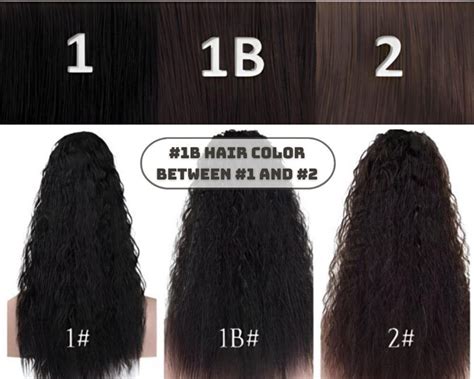Definition and Characteristics of 1b Hair Color
1b hair color, commonly known as “natural black”, is characterized by its extremely dark, cool tone. According to the Fitzpatrick Skin Type Classification System, individuals with 1b hair possess a skin type I or II, indicating very fair to light skin with high susceptibility to sun damage. The dominant pigment in 1b hair is eumelanin, which is responsible for its intense and rich black appearance. Eumelanin granules are larger and more densely packed in 1b hair, resulting in its high level of absorption and minimal light reflection.

Statistics and Prevalence of 1b Hair Color
According to the World Health Organization (WHO), 1b hair color is found in approximately 30% of the global population, making it one of the most prevalent hair colors worldwide. In certain regions, such as East Asia and Southeast Asia, the prevalence of 1b hair color is significantly higher, reaching up to 80%. Conversely, in regions like Europe and North America, the prevalence is lower, with only 15-20% of the population having 1b hair color.
Genetics and Inheritance of 1b Hair Color
The inheritance of 1b hair color is primarily determined by genetics, with two main genes influencing its expression: the MC1R gene and the SLC24A5 gene. The MC1R gene encodes the melanocortin-1 receptor, which plays a crucial role in regulating the production and distribution of melanin in the hair follicles. Variations in the MC1R gene are associated with different hair colors, including black, brown, and red. The SLC24A5 gene, on the other hand, is responsible for transporting solute carriers into the melanosomes, which are the organelles within the hair follicles that produce melanin. Mutations in the SLC24A5 gene can also lead to variations in hair color.
Cultural and Social Significance of 1b Hair Color
Throughout history, 1b hair color has held cultural and social significance in various societies. In many cultures, black hair has been associated with strength, power, and maturity. Ancient Egyptian queens, such as Cleopatra, were known for their striking black hair, which was considered a symbol of beauty and fertility. In some African cultures, black hair is revered as a source of pride and identity, often adorned with intricate hairstyles and accessories. However, in certain societies, 1b hair color has also been subject to discrimination and negative stereotypes, particularly in Western contexts where it was historically associated with “otherness” and inferiority.
Practical Considerations for 1b Hair Color
1b hair color requires specific care and maintenance to retain its health and vibrancy. Due to its high density and intense pigmentation, 1b hair can be prone to dryness and breakage. Regular moisturizing and deep conditioning treatments are essential to keep the hair hydrated and prevent split ends. Additionally, using a wide-tooth comb instead of a brush is recommended to minimize hair breakage. For styling purposes, heat protectants should always be applied before using hot tools to prevent damage.
Enhancing the Beauty of 1b Hair Color
There are various techniques and products available to enhance the beauty of 1b hair color. Glossing and highlighting are popular options for adding subtle dimension and shine to the hair without significantly altering its natural color. Color-enhancing shampoos and conditioners can also help to maintain the vibrancy and depth of 1b hair. For those seeking a more dramatic transformation, hair dyes specifically formulated for dark hair can be used to create richer, more saturated black tones.
Conclusion
1b hair color, with its deep, cool tone and global prevalence, holds both cultural and practical significance. Understanding the characteristics, inheritance, and care
